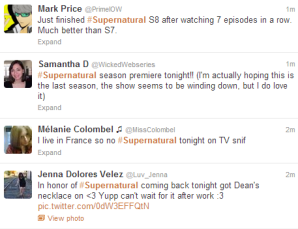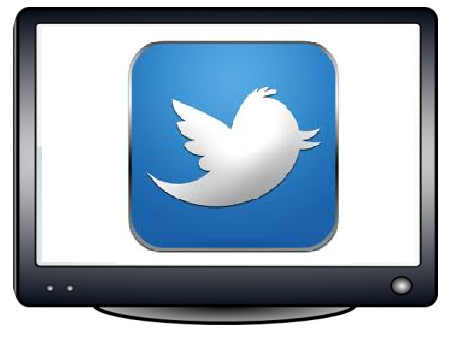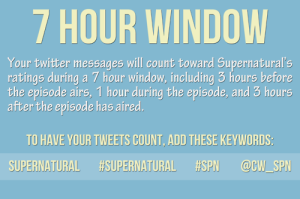Twitter and TV Ratings: Nielsen Catches Up With Technology
Sometimes when people urge others to “watch it on TV so it counts” I feel so incredibly bad for their misunderstanding of the ratings system. Unless you have a specific device called a Nielsen box hooked up to your TV, there is no way for networks to tell that you are watching their program. It’s a very old unit of measure that’s pretty far behind the times, to be honest, and I hate it. They recently added DVR viewings into account, which shows that they are trying to advance with changing technologies, but without a Nielsen box your own personal DVR habits still won’t be taken into account. The simple point of the matter is that if you don’t have a Nielsen Box (or their lesser used “diaries”), your TV viewing habits do not matter.
The Nielsen Company has just made a huge step towards taking into account viewers who are left out of the Nielsen system, though. They are turning to Twitter. Yes, Twitter. They will take into account how many tweets are made about a particular TV episode, the number of people posting about it, and the number of times those tweets were seen. I’m a little unclear about how the last one will be calculated, but the first two are extremely valuable to the average viewer who doesn’t have a Nielsen box hooked up to their TV.
HOW IT WORKS:
Say, for example, you’d like tonight’s episode of Supernatural to do well in the ratings. This is what you’ll need to do:
- You’ll want to tag your unique posts about the topic with “Supernatural” (with or without the #hashtag) within a 7 hour window of the show airing. The three hours preceding the show, the hour of the show, and the three hours afterwards will all be taken into account. This is not a time to spam with nothing but a hashtagged title of your favorite show, however. Only unique tweets will be taken into account. If you plan on posting “#Supernatural” 100 times in a row with no content, you are wasting your time and clogging up the tag. Please don’t do that, okay?
- Follower count seems to also be a contributing factors. For information on how this comes into play, take a look at this wonder post on Tumblr. They sum it up far better than I can and use pretty graphics (one of which I’m taking and putting to the right here because it is very informative and helpful. Four for you, Tumblr user. You go, Tumblr user).
- You’ll also want to be sure your account isn’t locked. Your account needs to be visible in order for the tweets to be recorded. This might seem like common sense, but I’ve seen plenty of people with protected accounts tweeting up a storm for campaigns not realizing that all of their effort is in vain.
- Another important tip is that you’ll want to keep to only one or two hashtags per tweet as any more than that will be viewed as spam by Twitter. A tweet that reads “I’m enjoying tonight’s episode of #Supernatural” is far more useful than “#Supernatural is great #SPN #SPNSeason9 #Season9.” You want your tweets to count, right? Good. Then don’t abuse hashtags.

Calculations of Nielsen’s Twitter Analysis indicate that a Twitter audience for a show is about 50 times larger than the amount of authors who are tweeting about it. If there are 1,000 people tweeting about it, that’s indicative of 50,000 people viewing those tweets. If you go onto Twitter and talk about the show you love as it airs, you are essentially representing 50 people to the networks. Kind of makes you feel powerful, doesn’t it?
So why is this important now?
Ad revenue. People are turning away from traditional viewing experiences, as is evident with Nielsen’s inclusion of DVR ratings, which means that traditional advertisements are no longer relevant. People are live streaming east coast feeds, downloading episodes soon after they air (usually from nefarious sources), and watching it together with friends at ‘viewing parties.’ People aren’t sitting alone in their living rooms being isolated from other viewers anymore. And Twitter offers adspace to the audience that is watching it through different means. To networks, that’s huge. It might seem shallow to the casual viewer, but that’s sort of the point of the ratings system in the first place. The more people watch a program, the higher they can charge for ratings, and the better chance they have of keeping the show that you love on the air.
Author: Angel Wilson
Angel is the admin of The Geekiary and a geek culture commentator. They earned a BA in Film & Digital Media from UC Santa Cruz. They have contributed to various podcasts and webcasts including An Englishman in San Diego, Free to Be Radio, and Genre TV for All. They identify as queer.
Help support independent journalism. Subscribe to our Patreon.
Copyright © The Geekiary
Do not copy our content in whole to other websites. If you are reading this anywhere besides TheGeekiary.com, it has been stolen.Read our



2 thoughts on “Twitter and TV Ratings: Nielsen Catches Up With Technology”
Comments are closed.